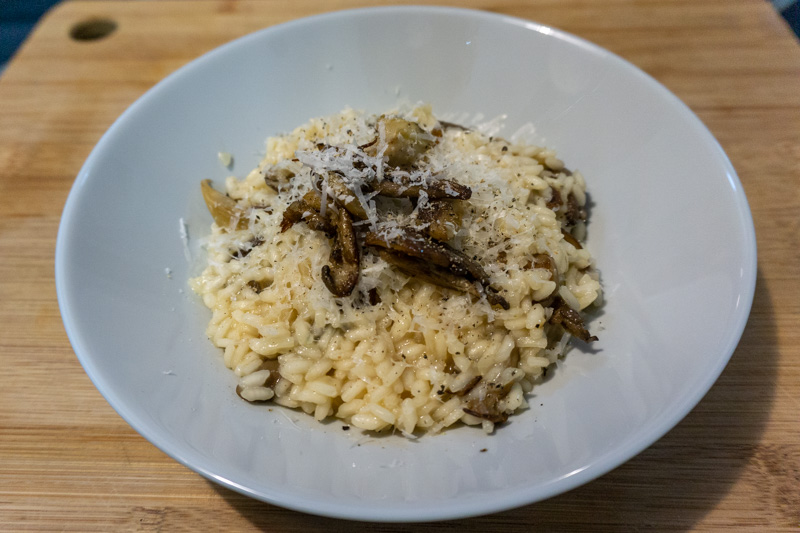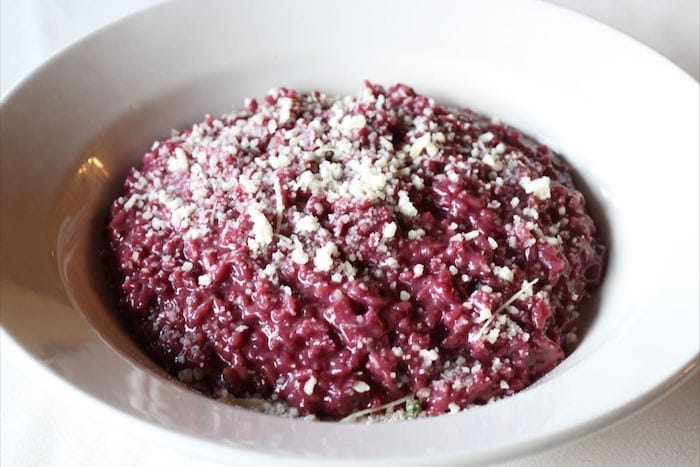Can You Make A Risotto Without Wine? Yes.. Here's How!

I enjoy making risotto, and while I’ve usually followed fairly standard recipes, I’ve always been curious about creating risotto without alcohol.
So, here’s how to prepare risotto without the use of wine.
Risotto is traditionally made with white wine and chicken stock. The wine adds acidity and balance to the risotto. For those who don’t have or don’t want to use wine in their risotto, 1-3 teaspoons of white wine vinegar added to the broth serves as an excellent substitute.
After all, even when the alcohol cooks off, individuals who do not consume alcohol may not want to keep it in the house.
But there’s a lot more to a risotto than that, so let’s delve a little deeper. You might be surprised by the outcomes.
What exactly is risotto?

Risotto is an Italian rice dish prepared using Arborio rice.
The rice is cooked until it is tender, creamy, and al dente in a mixture of white wine and stock. You can add a million other ingredients to it, and I’ve prepared it with the following ingredients over the years:
- Porcini mushrooms, fresh
- Asparagus
- Parmesan cheese, freshly grated
- Oil made from truffles
- Mussels
But that’s just the tip of the iceberg. If you’ve never tasted risotto before, you’re missing out. The rice is soft, and the sauce is creamy (but not mushy). Because you add the liquid a little throughout the cooking process, the flavors blend effectively.
As a result, the liquid has ample opportunity to seep into the rice and other ingredients.
Is wine required for making risotto?
The wine complements the stock and other flavors in the risotto. It also adds acidity to the dish.
Is wine, however, required for risotto? In a nutshell, the answer is no.
It’s unnecessary, and a superb risotto may be made without it. However, I would add 1-2 tablespoons of white wine vinegar to the stock to add acidity that the risotto would otherwise lack.
Is it possible to make risotto with white wine vinegar?
Certainly not. We’re talking vinegar here, whether it’s created from wine or not. Vinegar is quite acidic by nature. Wine has a well-balanced acidity, whereas most kinds of vinegar will leave you puckering for days if consumed in large quantities.
A tablespoon or two would suffice if you’re preparing risotto without wine and want a dash of acidity to go with your chicken or vegetarian broth. But don’t just use wine vinegar instead of wine in this or any other dish!
In a risotto, what may you use instead of wine?
To make risotto without wine, we need the same liquid that the recipe calls for. Instead, combine that quantity of broth with 1-2 tablespoons of white wine vinegar to provide the acidity you’ll need.
But first, let’s take a look at the overall flavors of a fantastic risotto. In risotto, the following flavors are essential:
Creaminess – from the rice’s starch and whatever freshly grated parmesan you add.
Acidity - is a term used to describe how acidic a bottle of wine is.
Richness - from the stock you keep adding throughout the cooking process.
As a result, if you’re learning how to cook risotto without wine, keep that in mind as you add your stock.
Traditionally, you would cook your risotto with chicken stock, which you would add (in minor amounts) after sautéing the rice in oil or butter. If you or your friends and family are vegetarians, you can, of course, use veggie stock.
Because of the heavier nature of beef broth, I would generally avoid using it unless the other components would benefit from it.
Can I use red wine instead of white wine in risotto?

Yes. Risotto is made with wine to give the rice a bit of acidity. The risotto will be darker due to the red wine, but it will still be wonderful. After sautéing the rice in oil or butter, the first step is to add the wine.
Remember that delightful wines (such as sherry or most rosés) should be avoided. They would tend to muddle the risotto’s flavor in an unappealing way.
Any wine branded “cooking wine” should also be avoided. Typically, this is merely cheap, oxidized wine with salt added. In a nutshell, don’t cook with anything you wouldn’t drink. You don’t have to use that $60 Châteauneuf-du-Pape, but neither should you use the super-cheap stuff.
Do you cover the risotto as it cooks?

Cook the risotto without covering it. Risotto necessitates steady stirring and the addition of tiny volumes of stock regularly. If you cover the risotto with a lid, it will dry out and burn.
A good risotto relies on adding stock a little at a time (usually approximately 1/4 cup) and stirring almost regularly to keep the rice from sticking to the bottom of the pan.
After the liquid has been absorbed, you can add more. The rice is cooked for another 20 minutes, constantly stirring, until it reaches the desired texture.
Covering the saucepan would hinder stirring, causing the rice to adhere to the bottom of the pan (and eventually scorch). You’ll end up with a large pot of gruel if you add all the liquid at once; not what you want in risotto!
What can I substitute for the risotto rice?

Risotto is traditionally made with Arborio rice. If Arborio rice is unavailable, any of the following rice varieties can be substituted:
- Rice for sushi
- Valencia
- Bomba
- White rice with a short grain
- Vialone Nano
- Carnaroli
Arborio rice is ideal for risotto because of its high starch content and rounded shape.
It’s a type of rice with short grains. It is more al dente (chewier) when cooked than other types of rice, which helps it not to turn to mush.
Arborio rice was difficult to come by when I first began preparing risotto. Allowing Uncle Ben into the kitchen at this time is not a good idea! If you can’t locate Arborio, don’t use any rice you have on hand instead.
My first two selections from the above list, which may be more challenging to come by than Arborio, are:
- Vialone Nano
- Carnaroli
These rice are excellent medium-grain Italian varieties with a unique texture and starch content, and they would produce a fantastic risotto. In fact, some Italian chefs prefer these to Arborio since they contain more starch and keep their texture better.
On the other hand, those looking for Arborio are unlikely to come upon them.
Long-grain, low-starch rice like basmati and Jasmine should be avoided at all costs. Avoid any form of converted or quick-cooking rice (typically pre-cooked, then dried). You’ll wind up with a (delicious) bowl of mush, and your family will wonder why you’ve stopped loving them.
Is it possible to make risotto with brown rice?

If you’re making risotto the conventional way, which involves adding small stock and constantly stirring, brown rice won’t work. Brown rice’s bran and germ prevent the starch from being released while cooking. Brown rice takes a lot longer to cook than white rice.
Make no mistake: if you Google “brown rice risotto,” you’ll find a plethora of options.
The majority of them call for the risotto to be baked or cooked. They may be fantastic, but it is not authentic risotto, in my opinion! So, if you want to try something new, go for it. However, if your Italian grandmother is visiting from her homeland, you should avoid any recipes that call for brown rice.
Brown rice is more nutritious than white rice because it contains both the bran and the germ, removed when white rice is made. Brown rice, on the other hand, offers a lot more fiber and nutrition than white rice.
White rice has fewer vitamins, minerals, and antioxidants than brown rice. However, this method will not work if you want to produce a delicious, conventional risotto. Add a gorgeous tossed salad to your risotto for added nutrition.
Have I addressed all of your concerns about making risotto without wine?
We looked at the world of creamy, delectable risotto in this article! To make your risotto creamy, delicious, and acidity-balanced, you’d traditionally use a combination of white wine and chicken stock.
However, some people do not keep the wine in their homes or do not drink and do not want alcohol in their cuisine (although technically, it does cook off). We also addressed the most often asked issues concerning risotto, such as which rice to use and how to prepare it.
Finally, we looked at how to create risotto without wine while maintaining an excellent acidity balance and creamy texture.











